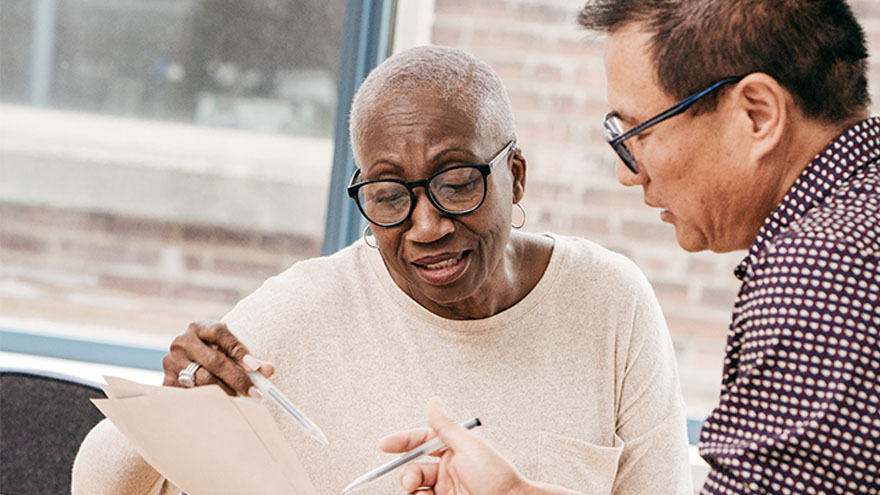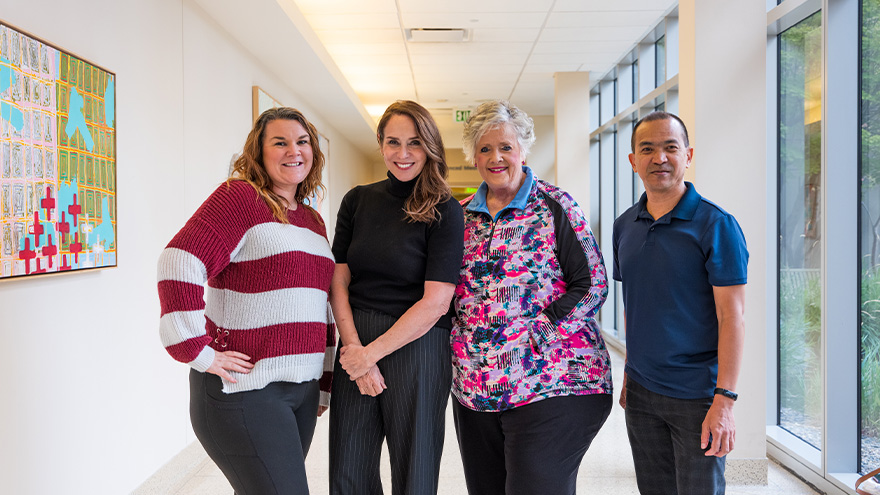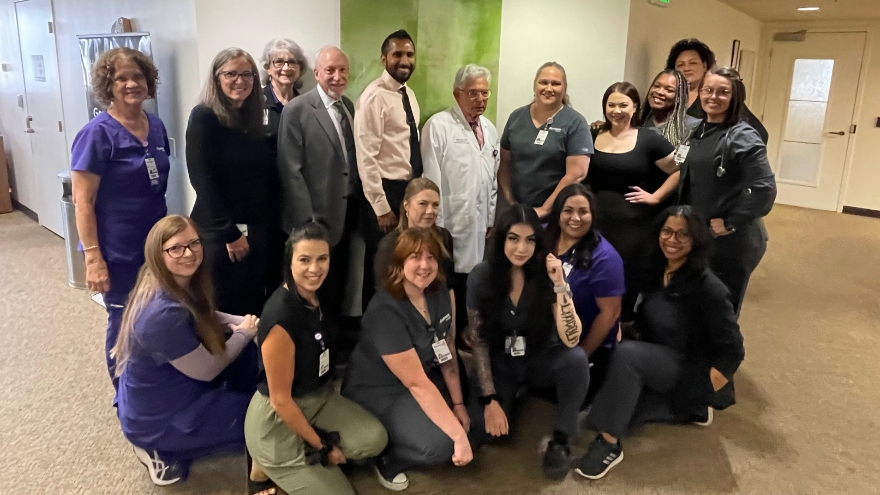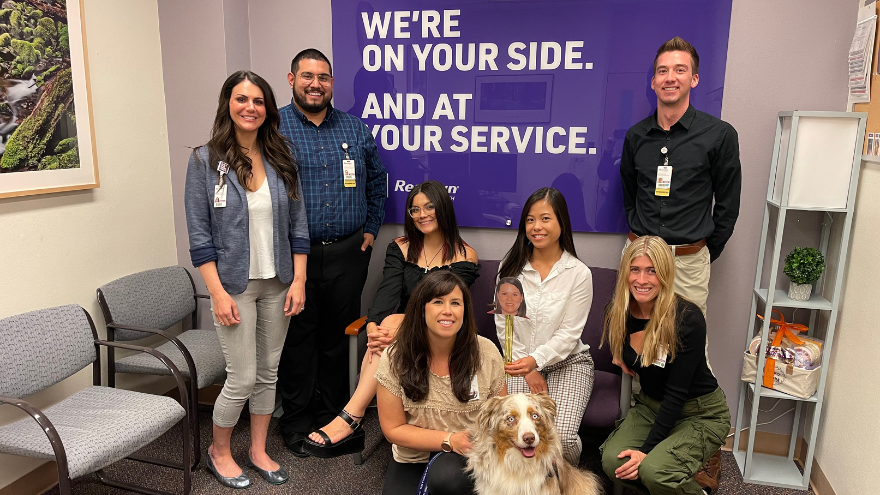Search
-
Navigating Renowns Cancer Care Resources Your Essential Guide
Cancer is challenging, but no one has to go through it alone. Patients and their loved ones can navigate the journey towards healing and recovery with the proper support and resources from Renown Health. When faced with a cancer diagnosis, access to reliable and comprehensive cancer resources is key. These resources provide vital information, support, and guidance for patients, caregivers and loved ones throughout cancer treatment and recovery. Cancer Resources Breast Cancer Newly Diagnosed Orientation Class Cancer Support Groups Caregiver Support General Cancer Support Group Lymphedema & Physical Therapy Men’s Prostate Cancer Support Group Newly Diagnosed Breast Cancer Workshop Smoking Cessation Spiritual Center Activities & Programs Sterling Silver 55+ Club Facebook Group At Renown and in collaboration with community partnerships, we offer a variety of resources and specialty care programs focused on improving the quality of life after cancer including: Cancer support groups play a crucial role in providing emotional, psychological, and practical assistance to those affected by cancer These groups often consist of individuals who have been through similar experiences and can offer guidance, empathy, and understanding. They provide a safe space for individuals to share their feelings, concerns, and experiences with others who truly understand what they are going through.
Read More About Navigating Renowns Cancer Care Resources Your Essential Guide
-
A Token of Appreciation: Renown’s Employee Giving Program
Pictured above from left to right: Jessica Bajwa, Nancy Bell, Laurie Goodman and Troy Fernandez As we approach the holidays and the season of giving, we reflect on the generosity and kindness that our employees here at Renown embody. Since 2007, Renown employees have donated $2,931,018 through Renown’s Employee Giving Program. This program provides our staff with the opportunity to make a difference by funding advanced equipment, research, community health initiatives, professional training and more. Regardless of the dollar amount, every contribution has a meaningful impact and remains entirely within Renown to support our mission. Employees can participate in the program at any time of the year by signing up for recurring payroll deductions or by making a one-time donation of any dollar amount. They can donate to one of Renown’s top priority areas of support or a different fund of their choice. Meet Jessica, Nancy, Laurie and Troy Renown employees Jessica Bajwa, Nancy Bell, Laurie Goodman and Troy Fernandez all have their own reasons for participating in the Employee Giving Program, but they all share the same goal: To give back to their community. Jessica Bajwa has been working at Renown for about seven years. She was at an employee event five years ago and found out about the Employee Giving Program through Renown Health Foundation. They explained the different areas she could donate to and how to get signed up. When Jessica looked back on the comforting care and healing her daughter had received at Renown Children’s Hospital, she felt empowered to give back to other children and families staying at Renown, so she enrolled in recurring payroll deductions to donate to Healing Arts. “It’s so easy and convenient to sign up,” said Jessica. “It means a lot to me to give to this area where they provide a healing environment, especially for patients and families at Renown Children’s Hospital – My daughter still has a blanket they gave her when she was there,” Jessica said she likes that the Employee Giving Program allows employees to choose their area of support to donate to and donation amount. Nancy Bell said she’s proud to give back to Renown after having received a great amount of support from her coworkers during an incredibly difficult time when a family member of hers was being cared for in Renown’s ICU, just three weeks into her employment at Renown. “I had employees from not just my team but also across the organization reaching out to me and checking in to see how I was doing,” said Nancy. Nancy said she was positively impacted by that kind of support through her work family at Renown and decided to start giving back in 2011 by signing up for recurring payroll deductions to donate to the William N. Pennington Cancer Institute – to this day, she is still making donations to this area of support. When Laurie Goodman began working at Renown in 2013, Renown’s Human Resources team offered her different ways to give back as an employee. “At the time, I was often caring for foster children and seniors,” said Laurie. “My family and I have always wanted to help others in need.” Laurie had been taking care of an elderly woman who was a patient at the old Renown Skilled Nursing Facility and decided to enroll in payroll deductions to donate to this facility. When that facility closed, she received a letter asking which area she wanted to transfer her donations to, and she decided to begin donating to Renown Children’s Hospital to give back to kids in the community. “I’m fortunate for not only my employment at Renown, but my husband’s and daughter’s employment as well. As employees of Renown, we have such great jobs, benefits and opportunities, and I think we should all strive to give back to express our gratitude and appreciation.” At his employee orientation in 2012, Troy Fernandez heard about Renown’s Employee Giving Program and learned that funds were needed for individuals who needed financial support to pay for healthcare services at Renown. He knew his donations would go to a good cause and signed up for recurring payroll deductions to donate to the Greatest Need Fund. “It feels good to be able to give back to those who are less fortunate than us,” said Troy. “It was very easy to enroll in this program, and I’ve been donating to the same support area ever since.”
Read More About A Token of Appreciation: Renown’s Employee Giving Program
-
Health Insurance Terms Explained: Deductible and Out-of-Pocket Maximum
Health insurance might be one of the most complicated purchases you will make throughout your life, so it is important to understand the terms and definitions insurance companies use. Keep these in mind as you are comparing health insurance plan options to choose the right plan for you and make the most of your health insurance benefits. One area of health insurance that can cause confusion is the difference between a plan's deductible and out-of-pocket maximum. They both represent points at which the insurance company starts paying for covered services, but what are they and how do they work? What is a deductible? A deductible is the dollar amount you pay to healthcare providers for covered services each year before insurance pays for services, other than preventive care. After you pay your deductible, you usually pay only a copayment (copay) or coinsurance for covered services. Your insurance company pays the rest. Generally, plans with lower monthly premiums have higher deductibles. Plans with higher monthly premiums usually have lower deductibles. What is the out-of-pocket maximum? An out-of-pocket maximum is the most you or your family will pay for covered services in a calendar year. It combines deductibles and cost-sharing costs (coinsurance and copays). The out-of-pocket maximum does not include costs you paid for insurance premiums, costs for not-covered services or services received out-of-network. Here's an example: You get into an accident and go to the emergency room. Your insurance policy has a $1,000 deductible and an out-of-pocket maximum of $4,500. You pay the $1,000 deductible to the hospital before your insurance company will pay for any of the covered services you need. If you received services at the hospital that exceed $1,000, the insurance company will pay the covered charges because you have met your deductible for the year. The $1,000 you paid goes toward your out-of-pocket maximum, leaving you with $3,500 left to pay on copays and coinsurance for the rest of the calendar year. If you need services at the emergency room or any other covered services in the future, you will still have to pay the copay or coinsurance amount included in your policy, which goes toward your out-of-pocket maximum. If you reach your out-of-pocket maximum, you will no longer pay copays or coinsurance and your insurance will pay for all of the covered services you require for the rest of the calendar year.
Read More About Health Insurance Terms Explained: Deductible and Out-of-Pocket Maximum
-
Copays vs. Coinsurance: Know the Difference
Health insurance is complicated, but you don't have to figure it out alone. Understanding terms and definitions is important when comparing health insurance plans. When you know more about health insurance, it can be much easier to make the right choice for you and your family. A common question when it comes to health insurance is, "Who pays for what?" Health insurance plans are very diverse and depending on your plan, you can have different types of cost-sharing: the cost of a medical visit or procedure an insured person shares with their insurance company. Two common examples of cost-sharing are copayments and coinsurance. You've likely heard both terms, but what are they and how are they different? Copayments Copayments (or copays) are typically a fixed dollar amount the insured person pays for their visit or procedure. They are a standard part of many health insurance plans and are usually collected for services like doctor visits or prescription drugs. For example: You go to the doctor because you are feeling sick. Your insurance policy states that you have a $20 copay for doctor office visits. You pay your $20 copay at the time of service and see the doctor. Coinsurance This is typically a percentage of the total cost of a visit or procedure. Like copays, coinsurance is a standard form of cost-sharing found in many insurance plans. For example: After a fall, you require crutches while you heal. Your coinsurance for durable medical equipment, like crutches, is 20% of the total cost. The crutches cost $50, so your insurance company will pay $40, or 80%, of the total cost. You will be billed $10 for your 20% coinsurance.
-
Celebrating World Lung Day in Northern Nevada
In the United States, electronic cigarettes are the most popular form of tobacco product used among high school students. Approximately 21% of Washoe County area high schoolers report current use of e-cigarettes, higher than the national average of 14% reported in the most recent national data. While often viewed as a safer alternative to traditional cigarette use, e-cigarette use, commonly referred to as vaping, exposes users to nicotine and harmful chemicals that stunt brain development, results in lung damage and harms overall health. In partnership with Reno area school principals and nurses, the Renown Health – UNR Med Clinical Research Office was able to provide this year’s World Lung Day Anti-Vaping Program to Galena High School, Robert McQueen High School and Sage Ridge School, reaching hundreds of high school students.
Read More About Celebrating World Lung Day in Northern Nevada
-
Department Spotlight: Medical Oncology
The month of September recognizes several cancer-related health observances. Join us in celebrating our Medical Oncology team at Renown! No person ever wants to hear the words, “You have cancer.” Those three short yet impactful words immediately change the course of someone’s life. As these patients Fight the Good Fight against cancer, there are a lot of intimidating unknowns that can take over their minds. What happens next? What will my treatment be like? What is my prognosis? How will I be able to handle this physically and emotionally? What will it take for me to beat this? Who is better to be by their side than the devoted team members at the William N. Pennington Cancer Institute at Renown Health? From helping patients manage the process of complex paperwork and referrals to delivering personalized oncology and hematology treatment options tailored to each individual diagnosis, those fighting virtually any type of cancer are never alone, thanks to this team. The William N. Pennington Cancer Institute always lives up to that promise, guiding patients through the daunting journey of cancer treatment ahead, one step at a time. Courageous Against Cancer Our exceptional Medical Oncology department inherently understands that each moment in life is precious, especially for patients battling cancer. This team is dedicated to orchestrating the most comprehensive plan for each patient, seamlessly weaving together diagnoses and treatments, oral chemotherapy, medication management, clinical trials, radiation oncology and more. With the many patients they impact, there’s no question that there is never a dull moment in the day of the life of a healing hero like those in this department. “No day is the same in Medical Oncology,” said Hollyann Dehm, Registered Nurse. “As a nurse, we wear many hats in the clinic. Our role is to educate patients on their treatment plans and specific drugs they are receiving, triage symptom calls from patients, refill medications and implement our oral chemotherapy program. We help provide direct patient care by accessing ports, drawing labs and giving IV hydration when needed. We also help fill out family and medical leave (FMLA)/disability paperwork, help with physician orders, help obtain prior authorizations for prescribed medications and treatments.” “We do our best to let our patients know that they will not be going through this alone,” added Danielle Say, Physician Scheduling Coordinator. "We will be here for them every step of the way, guiding them and making sure their treatment is as smooth as possible and making ourselves available to them as much as we can. We end up getting to know many of our patients on a very close, personal level, and this helps to build that trust.” “Our day-to-day activities include seeing patients and helping to manage their therapies as well as their toxicities,” added Dr. Harry Menon, DO, Oncology Physician. “We work closely with our infusion room staff and have a robust team to help us deal with these complex patients. We also work very closely with our surgical and radiation oncology colleagues in a multidisciplinary fashion to provide comprehensive care for our patients.” The Medical Oncology team excels not only in providing cutting-edge cancer care but also in their compassionate approach to helping patients reduce the anxieties they understandably feel. Recognizing that a cancer diagnosis can be an emotionally overwhelming experience, this dedicated team combines medical expertise with unwavering support to create a healing environment. “When patients are referred to our department, a lot of them have many fears and questions,” said Heather Cortez, Medical Assistant. “A majority of what our team does is focused on the mental support that our patients require to help them have the most successful outcomes. One thing I have learned about cancer care is that positivity in the face of adversity is everything. Just being there to listen to our patient’s concerns can make all the difference. Helping them to navigate their many appointments and taking the time to explain things in a patient and compassionate way, is part of how our team serves this vulnerable population.” “The uncertainty is one of my patients' biggest fears: How far has my cancer progressed? How long will I have left? Is treatment even an option?” added Mary Wilson, Senior Medical Assistant. “The best advice that I can give my patients is that they are not alone. While this battle is going to be one of the hardest parts of their lives, they are surrounded by constant support to try and help with any burdens they may be facing. I also tell my patients that we have to take the little wins no matter how small they may be, because while cancer treatment is a physical battle, it is also a large mental battle." “While we don’t have answers to all the questions patients and their family members may have, we do our best to listen to their questions and concerns regarding their cancer diagnosis and treatment and guide them through their cancer journey," added Hollyann Dehm. “We provide emotional support and education on their type of cancer, managing their pain and side effects of their treatment. We also connect them to nurse navigators and our social worker who also help identify barriers to care and provide the patient with resources.” Whether it's explaining treatment options in understandable terms or offering emotional support through difficult moments, this department is committed to empowering patients on their journey toward healing. Their holistic approach not only treats the disease but also nurtures the spirit, all while being a strong advocate on each patient’s behalf. “Getting a cancer diagnosis can be the worst news that a person can hear; what we try to do is focus on improving quality life and focus on goals that help to promote quality of life,” said Dr. Harry Menon. “If the option for a cure is on the table, we try and focus on that goal in concert with promoting quality life. I try and have our patients focus on what they can control, with the understanding that even if some things are out of our control, the way we approach and manage those things, including our mindset, is still within our control.” “In our clinic, we truly value our patients and how they are cared for,” added Mary Wilson. “The amount of compassion our team shows is incredible. Patients constantly commend our team on how much they feel like the provider's care. Our providers and staff are not afraid to advocate for patients and that truly is an accomplishment in and of itself.” “We know patients are only hearing a small amount of the immense volume of information we provide them, so we encourage them to ask questions until it makes sense because the timeframe is different for every patient,” said Lillian Morton, APRN of Medical Oncology. “Cancer is an anxiety inducing lack of control whirlwind – if we can help by being responsive to patient calls and messages, we do so.” With their harmonious and integrated approach, each patient’s treatment journey progresses uninterrupted, bringing them closer to a brighter and healthier future.
-
3 Ways to Foster the Wellbeing of LGBTQIA+ Kids and Teens
Ensuring a healthier and more inclusive future for LGBTQIA+ children and teens is of utmost importance to health systems in our community, especially Renown. Supporting the physical and mental health of youth in this community is key to those efforts, especially as they face unique challenges in terms of identity acceptance and social integration. Dr. Caroline Barangan, Adolescent Medicine Physician with Renown Children’s Pediatric Specialty Care, discusses what you as a parent, caregiver, friend or support system can do to be a safe space for children and teens who identify as LGBTQIA+. 1. Create a Safe Space at Home The most important action you can take for your LGBTQIA+ teen or child is to accept and support them for who they are, regardless of how they identify. “Being a teenager is already difficult enough, especially within the LGBTQIA+ community, which puts them at risk of being stigmatized, rejected and targets for bullying,” said Dr. Barangan. Your supportive words and actions can make a huge difference as a profound expression of love and understanding. Being patient and willing to learn are the foundations to a healthy and loving relationship with your LGBTQIA+ teen or child. 2. Encourage Regular Check-Ups with a Primary Care Provider (PCP) Establishing your child or teen with a PCP is not only important when an illness occurs but also for annual preventative visits and regular check-ups. “A primary care provider can screen for high-risk behaviors that would put a patient’s health in jeopardy, such as sexual experience, substance use, suicidality and self-harm,” said. Dr Barangan. “These screenings are an opportunity to provide the education and support these kids and teens need to stay healthy.” One of the main concerns LGBTQIA+ youth often have is that they will experience judgment from their provider, or the PCP will disclose sensitive information, including their sexuality or gender identity to their parents, when they are not ready to do so. Dr. Barangan emphatically reminds us that this legally cannot happen. “If a patient asks me to keep something confidential, unless they disclose that they have plans to harm themselves or others, I am legally not allowed to share that information with anyone without their permission,” said Dr. Barangan. 3. Locate Local Resources Northern Nevada is home to a variety of resources for the LGBTQIA+ community at large, including youth members of this community. "Finding resources to help them develop in a positive way and provide them with the information they need, whether it be in school, the household, the community or through a medical or mental health provider, is incredibly important,” said Dr. Barangan. Below is a list of local LGBTQIA+ community resources open to you and your children: Our Center LGBTQIA+ Health Services at Northern Nevada HOPES Northern Nevada Pride Festival & Community Parade (happens every July in Reno) Sassabration (happens every September in Carson City) Lake Tahoe Pride (events and resources shared on Facebook) © alessandrobiascioli via Canva.com
Read More About 3 Ways to Foster the Wellbeing of LGBTQIA+ Kids and Teens
-
Why Is My Hair Falling Out? Alopecia Explained
© MikeSaran via Canva.com Hair is often considered a symbol of identity and self-expression, from scalps and eyebrows to beards and bodies. But what happens when this symbol starts to fall out? The 6.7 million people across the country living with alopecia know this feeling all too well. Alopecia, or hair loss, is a medical condition with variable causes, presentations and treatments. Experts at Renown Health dive into the world of alopecia, its causes and how to address it – especially as we embrace National Alopecia Awareness Month this September. Types of Alopecia The term “alopecia” is a broad umbrella term that encompasses many different forms of hair loss that can present itself at any age, no matter your gender or ethnicity. The most common types include: Alopecia Areata: An autoimmune disorder where the immune system targets hair follicles, typically resulting in patches of hair loss on the scalp and/or other body parts. More severe forms of alopecia areata also exist, such as alopecia totalis and alopecia universalis. Androgenetic (or Androgenic) Alopecia: A disorder also known as male or female pattern baldness that causes gradual hair thinning and loss often around the temples and crown. Unlike alopecia areata, this form of alopecia is usually hereditary. Telogen Effluvium: A condition resulting in hair shedding, typically after high-stress or infectious events, such as after giving birth or after a COVID-19 infection. This usually resolves itself within a few months to a year. Traction Alopecia: Hair loss resulting from the effects of tight braiding or styling of the hair, which can cause permanent loss over time. Scarring and Inflammation-Mediated Hair Loss: Patterns of hair loss related to lupus, lichen planus or other autoimmune conditions that can unfortunately be permanent and progressive. Options to Treat Alopecia While there isn’t a cure for most types of alopecia, some treatments are available to help minimize the effects of the condition and promote hair growth. Treatment varies depending on the type of alopecia. Potential options can include: Topical Minoxidil: An FDA-approved over-the-counter medication available in foam or liquid form and applied directly to the scalp, which helps stimulate hair growth by increasing blood flow to hair follicles. Hormone Therapies: A hormone regimen that can help minimize the resulting hair thinning and balding. Corticosteroids: A topical cream or ointment – or an injection for severe cases – that help reduce inflammation and re-grow hair. Low-Level Laser Therapy: A therapeutic, non-invasive intervention involving wearing special caps or combs that release painless, low-level lasers to stimulate hair follicles. Healthy Diets and Nutritional Supplements: A diet rich in vitamins and minerals essential for hair health, such as biotin and collagen, can aid in recovery. Vitamin D and iron are also important hair growth nutrients. Stress Management: Stress can impact the speed and frequency of hair loss. Managing your stress can help mitigate the effects of alopecia. Treatment for alopecia is not a one-size-fits-all approach. A scalp skin biopsy may help determine a cause for hair loss and help guide the best management strategies with your provider. Addressing the Emotional Impacts Even though alopecia isn’t life-threatening, the impacts of the condition can affect your self-esteem and self-image. The most powerful tool to help you manage alopecia is knowledge. Keeping yourself educated about your condition, and encouraging your loved ones to do the same, can help arm yourself with the acceptance and self-compassion you need and help combat misconceptions. With the rise in awareness in the mainstream media for alopecia and other hair conditions, beauty standards and fashion are shifting to become more inclusive for those experiencing hair loss. Celebrating the many diverse hairstyles and fashion statements can help you regain your confidence. There are many options you can advantage of to help style your hair and protect your scalp: Hairpieces: Wigs, extensions and other hairpieces can help cover up balding or thinning patches and add volume to your hair. Hairpieces have come a long way in the past few decades, and many use real human hair. Hats: Hats serve a dual purpose – a fun fashion accessory to help boost your confidence and a method of protecting your scalp from the sun. As someone with alopecia, your scalp is more exposed, and hats can provide that extra layer of protection you need. Scalp Sunscreens: While regular body sunscreens can provide good scalp sun protection, they can result in oily scalp and hair appearance. Sunscreens that are specifically designed for the scalp are available at most beauty stores or online. Remember, patience is fundamental, as many treatments require consistent use over time to see noticeable results. Stay resilient, and don’t give up – you are not alone in your alopecia journey.
Read More About Why Is My Hair Falling Out? Alopecia Explained
-
Department Spotlight: Patient Experience
At Renown Health, our commitment to the experience of all our patients and guests is not just a mission – it's a way of life. Our unwavering dedication to creating exceptional experiences for the communities we serve is what sets us apart. Every day, we strive to build a service culture of excellence, one that ensures that every person who walks through our doors has an extraordinary encounter that exceeds their expectations. Renown’s Patient Experience department is the team that fulfills this mission and more. These passionate individuals intimately understand that top-of-the-line service involves the entire healthcare continuum, from the first phone call when scheduling an appointment to the final discharge and follow-up instructions and everything in between. With this collective dedication, Patient Experience is consistently on a journey to redefine what it means to leave a lasting impact in the minds of patients, setting a new standard for healthcare excellence in our community. Our In-House Jack-of-All-Trades It takes a village to ensure every patient and guest continues to have a positive experience at every Renown location and maintains trust in our providers and employees. Our Patient Experience team serves as the mayors of that village, encompassing four main aspects of healthcare service: Service Excellence: Compiles, reviews and resolves patient complaints and concerns to help with service recovery and identify opportunities for improvement. Volunteer Services: Enhances the patient experience by leveraging dedicated youth, adult and college-aged volunteers in a variety of volunteer programs, including pet therapy, healing arts, hospice and more. Language Access: Provides qualified interpretation and translation services to assist our limited- or non-English-speaking populations. Data Management: Uses patient experience data, research and surveys to prioritize system, location and unit-specific service needs to improve clinical and quality outcomes. “Because our department has many segments, no day is the same, which keeps the work week exciting,” said Shelbi Whitehead, Manager of Patient Experience. “Whether we are hosting a pet therapy parade for patients, de-escalating and rounding with upset patients to provide service recovery, offering interpretations for our Limited English Proficiency (LEP) patients, or managing data for the organization, we have one goal in mind: to enhance the experience for our patients and guests at Renown Health.” Cultivating a sense of community and fostering trust in our health system, the Service Excellence team steps in to ensure no concern goes unnoticed and every opportunity to make a positive chance is addressed. “My day consists of listening to patient concerns, connecting with different department leaders and providing support, and working on projects to improve processes,” said Julianne Revilla, Customer Experience Specialist. “To help enhance the patient experience, I round with patients on different floors to know more about their stay and experience with us. If they have any issues or concerns, I let floor staff know and do our best to resolve the issue in the moment.” “My team and I have an amazing opportunity to work with multiple leaders throughout the organization to resolve any patient concerns and provide valuable feedback on how patients are doing while using services that we offer,” added Ricky Garcia Sanchez, Senior Patient Experience Specialist. “A typical day will involve calling patients, rounding with patients, communicating with leaders to resolve events, handling grievances and staying in compliance with Centers for Medicare and Medicaid Services (CMS) guidelines.” “It’s all about hearing what is upsetting them and letting them know that we care about them,” added Shay Morgan, Customer Experience Specialist. “We ask ourselves, what is the main concern the patient has, and what is it they are seeking? From there, we do our internal investigation through Midas and send it to leadership, and then we find a reasonable and appropriate solution or response to let the patient know we are looking into their concern.” As the only not-for-profit health system in the region, Renown depends on the dedicated service of our volunteers. Our Volunteer Services team deploys volunteers across many programs who make a significant difference in the lives of patients and their families. “On a typical day, I may be going between the volunteer information desks assisting that team with anything that comes up while they are helping guests,” said Wendy Peukert, Volunteer Coordinator. “We find wheelchairs for departments, provide guest escorts, deliver flowers and mail to patients, locate doctors’ appointments or anything else that helps someone that walks in the door. We ensure all our programs go smoothly by planning ahead while also being flexible to be ready for anything that comes our way and by keeping communication open with our volunteers. Patients and guests being greeted by friendly, knowledgeable volunteers who show empathy and care is my goal!” “Some of my best days at Renown are volunteering with my dog Moose, who is a certified therapy dog, and watching the healing he provides to patients and employees,” added Shelbi Whitehead. At Renown, we believe that language should never be a barrier to receiving care. Our Language Access team ensures that this goal is realized through providing expert interpretation and translation services. “Renown has many different resources we use to ensure LEP patients and visitors receive a positive, quality visit to our health system,” said Seth Rubin, Supervisor of Language Access. “With signage strategically placed at front desks and check-in areas, patients can point to their preferred language, and we can use the Language Line iPads, phone lines or a dual-role Qualified Medical Interpreter to communicate with the patient or visitor. Within EPIC, we can also set a patient’s preferred language indicating to Renown staff what language to use with the patient and prepare forms in that language. I always ensure all patients are provided with these proper language services, and I also help with employees taking our online interpreter certification course, as well as help when a department needs new Language Line equipment. Additionally, I enjoy meeting with community groups to stay informed on community updates, events and trends around language, immigration and more.” Renown values and utilizes the opinions of our patients across all corners of our health system Maintaining service transparency is a promise, and that promise is fulfilled by our Data Management team, who use all the research and survey tools at their disposal. “My daily work includes a lot of updating scorecards across the network, working with the tech teams to ensure the patient data is getting to the right places, training leaders, analyzing market data and maintaining the reports that go to every corner of Renown,” said Brooke Cyphers, Market Data Analyst. “Through a partnership with our patient satisfaction survey vendor, PRC, Renown ensures data integrity, neutrality and credibility in surveying patients in all our care areas. The data from completed surveys are compiled and disseminated to our providers and leadership at all levels with the goal of transparency and patient-centric practice. These surveys are incredibly important to process improvement directly targeted at addressing areas that have been mentioned by our patients. I love it when people reach out to dive into a particular initiative they want to track or an issue they want insights on.” In their relentless pursuit of excellence in service across many programs, the Patient Experience team remains steadfast in their commitment to delivering the highest quality care and experiences.
-
Guide to Injury Healing: Heat or Ice?
Heat and ice are two of the most common treatments used to relieve pain and reduce swelling in injuries. However, each one is better suited for certain types of injuries Dr. Luis Palacio, MD explores the differences between the two. When it comes to treating aches and pains, the debate between heat and ice has been ongoing for quite some time. Both have their benefits making it crucial to understand which option is better suited for your specific needs. Determining which method is better depends on various factors such as the type of injury or pain you are experiencing. For instance, if you have recently sprained your ankle or pulled a muscle during exercise, applying ice within the first 48 hours can help minimize swelling and alleviate discomfort. It's worth noting that some individuals find alternating between heat and ice therapy beneficial as well. This approach combines the benefits of both methods by using heat to increase blood flow followed by ice to reduce inflammation. Cold Therapy Cold therapy can help to reduce inflammation after an injury, heat can have the opposite effect. Therefore, heat therapy should be reserved for those who have chronic pain issues and are not dealing with an acute injury. Cold therapy is often recommended immediately after an injury or during the initial stages of inflammation. Cold therapy such as ice packs are especially effective in treating: Sprains Strains Any injury that involves swelling Heat Therapy Heat therapy is known for its ability to relax muscles, increase blood flow and soothe pain. It is often used for chronic conditions or injuries that are not inflamed. Applying heat can help alleviate stiffness, promote healing and provide a comforting sensation. This increased circulation can bring more nutrients and oxygen to the area, helping it to heal faster. Heat therapy such as heating packs are especially effective in treating: Stiffness with associated pain Injuries that are not inflamed Muscle pain
-
6 Healthcare Action Items for the LGBTQIA+ Community
Every patient, regardless of how they may identify, greatly benefits from preventive healthcare and early detection. Members of the LGBTQIA+ community face unique considerations when it comes to their health, and a proactive approach to preventive screenings and vaccines is important in order to address their individual health needs. Dr. Karen Thiele, Family Medicine Physician with University Health and Assistant Professor of Family and Community Medicine at the University of Nevada, Reno School of Medicine, breaks down key steps that LGBTQIA+ patients should take to safeguard their health. PrEP and PEP Pre-exposure prophylaxis (PrEP) is a strategy to prevent human immunodeficiency virus (HIV) infection. It is an important measure for those who are HIV-negative but may be at risk of contracting it. The highest risk sexual practice is receptive anal intercourse, due to the relative fragility of rectal tissue. This medication can stop HIV from spreading in the body and help patients maintain their HIV-negative status. PrEP is available in both pill form, which is taken every day, and injection form, of which the first two injections are initiated one month after another while all other injections are initiated every two months. Post-exposure prophylaxis (PEP) is an antiretroviral drug regimen taken after potential HIV exposure to prevent an HIV-negative individual from converting to HIV-positive status. PEP is only for emergency situations and must be started within 72 hours of exposure – sooner is always better than later – and must be taken for 28 days. PrEP and PEP are available in many ways, including visiting your primary care provider (PCP) or an urgent care location. HPV Immunization All genders and identities can protect themselves against human papillomavirus (HPV), a sexually transmitted infection (STI) that can lead to the risk of cervical, mouth, head, neck, throat, anal, vaginal, penile and vulvar cancers. HPV is so common that nearly all sexually active people, regardless of sexual orientation and practices, will be exposed at some point in their lifetime. The HPV vaccine (common brands include Gardasil and Cervarix) is a safe and effective method to prevent HPV, according to the Centers for Disease Control and Prevention (CDC). This vaccine protects against infections that can lead to HPV-related cancers and precancers, as well as genital warts. While patients should start receiving the vaccine at 9 years old years old, unvaccinated adults up to the age of 45 can also receive the vaccine through their PCP – better late than never!
Read More About 6 Healthcare Action Items for the LGBTQIA+ Community
-
6 Signs of Heart Failure
Heart failure is a serious medical condition that occurs when the heart is unable to pump blood effectively, leading to a variety of symptoms and potential complications. Although there has been progress made in the treatment of many forms of heart disease, heart failure continues to be a prevalent and life-threatening condition – nearly 6.2. million adults in the U.S. have heart failure. Recognizing the signs of heart failure is crucial for early detection and timely intervention. We talked to Ruth Skinner, APRN at the Renown Institute for Heart & Vascular Health, about recognizing common signs and symptoms of heart failure. Heart Failure Signs and Symptoms The symptoms of heart failure may be subtle and can be mistaken for normal signs of aging. Common symptoms of heart failure are due to extra fluid or congestion – typically starting with congestion of the lungs, then moving to different parts of the body. Common heart failure symptoms include: Breathing Difficulties (Dyspnea): One of the hallmark symptoms of heart failure is shortness of breath during daily activities and having trouble breathing when lying down. Fatigue and Weakness: Because heart failure can lead to reduced blood flow to the body’s tissue, patients may find themselves becoming tired and weak even during routine activities. Swelling (Edema): Fluid retention in the body can cause noticeable swelling. Weight gain along with swelling of the feet, legs, ankles or stomach is often a key sign of worsening heart failure. Rapid or Irregular Heartbeat: Heart failure can disrupt the heart's electrical signals, causing irregular heartbeats (arrhythmias) or a rapid heartbeat (tachycardia). These can be felt as palpitations or fluttering sensations in the chest. Persistent Cough or Wheezing: Fluid buildup in the lungs triggers a persistent cough, sometimes accompanied by pink or white mucus. Loss of Appetite or Nausea: Heart failure can affect blood flow to the digestive system, leading to symptoms like loss of appetite and nausea. If you or a loved one experiences any of the above signs and symptoms, it’s important to seek medical attention promptly.











